IELTS Task 2 Essay Editing Tips: Improve Your Essay in 5 Minutes
Even after you’ve written your IELTS Writing Task 2 essay, the work isn’t over. Many students make the mistake of stopping as soon as they finish writing the last word – but using the final few minutes to edit and polish your essay can significantly boost your score. In fact, IELTS experts stress that “learning how to self-correct and edit your writing is an important skill” for achieving your target band. Spending those last 5 minutes checking your work is vital: as one tutor warns, skipping this step “can spell disaster” for your score.
A good way to think about the exam is to allocate 5 minutes to plan, 30 minutes to write, and 5 minutes to revise. In the final 5 minutes, focus on fixing small errors and improving clarity. Even a quick revision can help you find and fix mistakes that normally get missed, which often cost points (especially in grammar and vocabulary). According to official guidance, you should use this time to check for errors in grammar, structure, coherence, and vocabulary. Below is a simple checklist of what you can achieve in 5 minutes:
- Find and fix grammar errors.
- Make your ideas clear.
- Use stronger vocabulary.
- Improve the overall flow and logic.
Each of these steps helps your essay meet IELTS criteria (Task Response, Coherence & Cohesion, Lexical Resource, and Grammatical Range & Accuracy) more effectively. In practice, you can follow a quick 3-step process: (1) after each sentence, scan for obvious mistakes; (2) after each paragraph, re-read for coherence; (3) then do a final pass over the whole essay. This structured approach ensures you catch the most important issues quickly.
1. Find and Fix Grammar and Spelling Errors
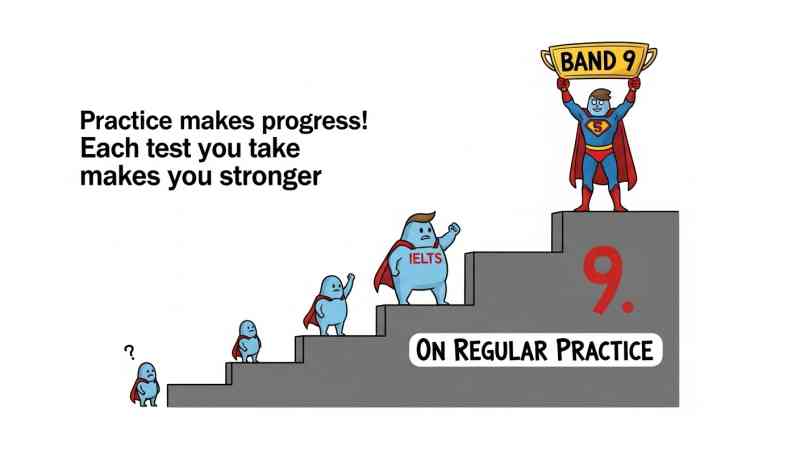
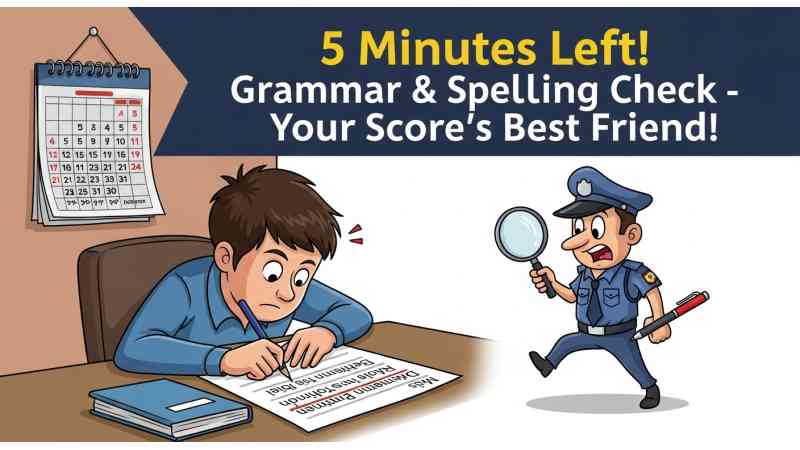
The most obvious errors to correct are grammar, spelling, and punctuation mistakes. Under time pressure, almost everyone makes small errors (subject-verb agreement, missing articles, wrong tense, comma splices, etc.). In your final minutes, read each sentence carefully. It’s often helpful to slow down or even read the last word first – this “defamiliarization” trick can help you spot a misspelled word or a missing “the.”
According to seasoned IELTS teachers, simply reading passively rarely reveals errors. Instead, actively look for the types of mistakes you know you make. For example, if you often forget an “s” on verbs, watch for that specifically. Check your subject-verb agreement in longer sentences, and make sure every noun has the correct article (“a/an/the”). Also verify your verb tenses – consistency is key unless you deliberately shift tense. If you spot a clumsy sentence or too-complex phrasing that likely caused a mistake, rephrase it simply.
In practice, you can break it down by sentence. After writing each sentence (in your head), do a quick scan for obvious errors. Focus on one thing at a time: first punctuation (are commas in the right place?), then verb forms, then word forms (e.g. correct adjectives vs. adverbs). Even if you don’t find anything major, correcting a few small errors can add a half or full band in Grammatical Accuracy. Remember: IELTS examiners know you have 5 minutes to check, so they will expect you to have caught simple mistakes like their/there, your/you’re, or its/it’s.
For spelling, if you’re unsure, run your eyes slowly over each word. Since IELTS is typed (Academic) or handwritten (General) under timed conditions, typos do happen. If a word looks odd, try a common alternative spelling or check if you accidentally added/omitted a letter. Don’t erase and rewrite an entire paragraph – just fix the word directly. In short, use your final minutes to eliminate stray commas, obvious grammar slips, and spelling errors. A cleaned-up essay shows examiners that you can write accurately under pressure.
2. Make Your Ideas Clear and Complete
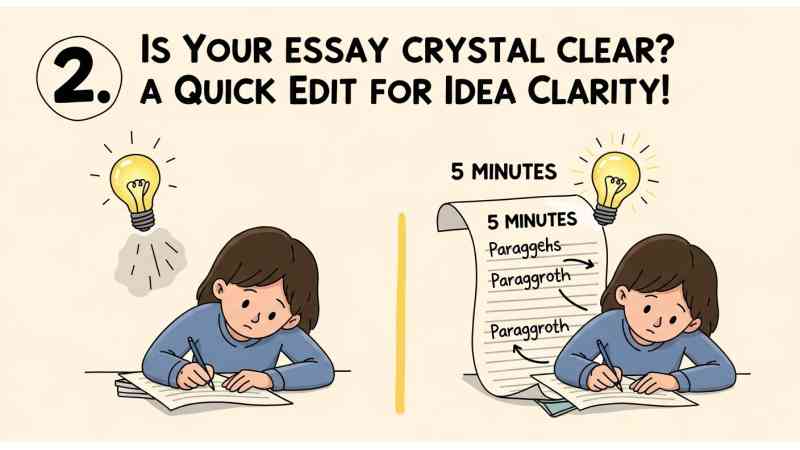
Next, ensure that your message is clear and fully addresses the question. Check that every part of the prompt has been answered in your essay. For example, if the question asks why something is happening and how to solve it, verify that you discussed both parts. You should also confirm that your introduction and conclusion match your main arguments. If your introduction promised three points, make sure you have all three, and that the conclusion summarizes what you wrote.
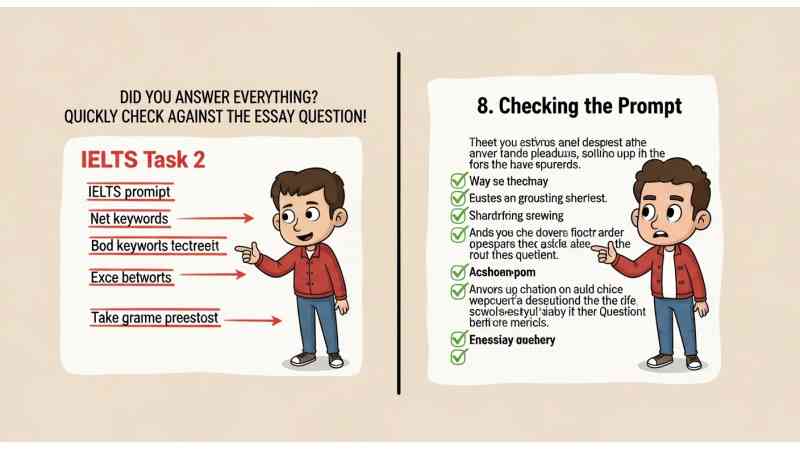
During editing, try to look at your essay from a reader’s perspective. Is your main point (thesis) stated clearly in the introduction? Does each body paragraph start with a topic sentence that relates to the question? If a paragraph feels off-topic or confusing, revise it. In some cases, you may need to add or clarify a sentence. For instance, if you made a claim without enough explanation, you can add a brief clarifying phrase or example.
Be careful not to introduce new ideas in your conclusion; stick to summarizing what you already explained. Also, check transitions: the reader should easily follow the logic from one paragraph to the next. If a connection is weak, insert a linking phrase (e.g. “In addition,” “However,” “For example,” etc.) to guide the reader through your reasoning.
Importantly, in 5 minutes you cannot restructure major parts of your essay. The overall organization (plan and main arguments) should already be solid from the writing phase. However, you can tighten unclear phrases. Read each paragraph and ask: “Would someone unfamiliar with my answer understand this point?” If not, reword any vague sentence to be more direct. Even adjusting a single word (changing an ambiguous term to a precise one) can improve clarity.
Finally, ensure you haven’t used any notes or bullet points (which are not allowed). Your essay should be full sentences and coherent paragraphs. If you notice a word left out of a sentence (for example, by mistakenly making a bullet-like list instead of a sentence), fix it now. By the end of these checks, your essay should answer the question fully and clearly, with a logical progression of ideas.
3. Use Stronger Vocabulary
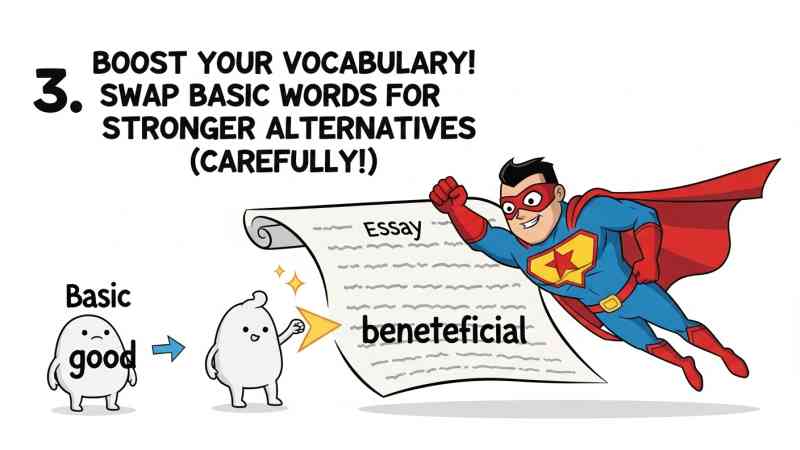
Good vocabulary can raise your Lexical Resource score. In the last 5 minutes, replace a few basic words with stronger synonyms. For example, if you’ve written “very important”, consider “crucial” or “significant”. If “good” appears repeatedly, think of alternatives like “beneficial”, “favorable”, or “advantageous.” Be cautious: only replace words with synonyms you are sure about to avoid new mistakes. Never use a word whose meaning you don’t fully know. The goal is to vary your language without compromising clarity.
Examiners note that “using a range of vocabulary accurately and appropriately can elevate the quality of the essay”. So focus on variety. If you’ve used the same linking word often (e.g. “and” or “also” many times), swap in alternatives like “moreover,” “furthermore,” “however,” or “on the other hand.” Changing a couple of words can give a fresh tone. Also check for informal language; replace words like “kids” with “children”, or “things” with a more precise noun.
While doing this, don’t overdo it. One or two strong replacements are enough. If you time it right, you might add a phrase or clause to sound more academic (for instance, add “for example,” “in fact,” “in other words,” etc.). However, avoid rare or overly complex words that might be misused. The examiner wants to see good vocabulary used correctly, not just big words thrown in. If you’re unsure about a replacement, it’s safer to leave it as is. In summary, correct any very basic or repeated words, and swap them with more precise vocabulary where possible to boost your essay’s impact.
4. Improve Cohesion and Flow

Good cohesion (smooth flow between sentences and paragraphs) is a key criterion. In your final check, make sure each paragraph links logically to the next. Look for spots where ideas jump abruptly. You can remedy this by adding or adjusting linking words. For example, if one sentence contrasts with the previous one, start it with “However,” or if it adds to the previous idea use “Furthermore,” or “Additionally,”. Be careful not to overuse the same connectors; vary them if possible. Also ensure that each body paragraph has a clear focus; if you see unrelated sentences, consider moving or deleting the off-topic bit if time allows.
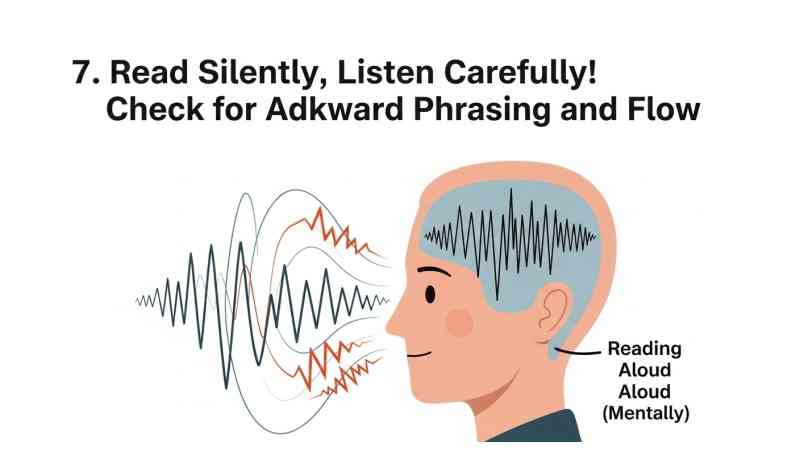
Read the essay aloud (mentally) and listen for any awkward pauses or jumps. Each paragraph should feel like one unit addressing a single point. If a paragraph seems disjointed, insert a short bridging phrase: e.g. “Another important point is…” or “This links to…”.
Use the checklist to guide you: make sure you’ve addressed cohesion explicitly. In practice, this means checking that pronouns clearly refer to the right nouns, and that there is at least one linking phrase per paragraph where appropriate. If you started an idea at the end of one paragraph and continued it at the start of the next, consider combining them or adding a transition sentence.
By the end of this review, your essay should “flow” naturally from introduction through conclusion. A coherent essay will keep the reader (and examiner) engaged and make your arguments convincing. Remember, even a well-argued essay can lose points if it feels jumbled. Use the final minutes to smooth out rough edges so your logic is crystal clear.
Quick Final Checks
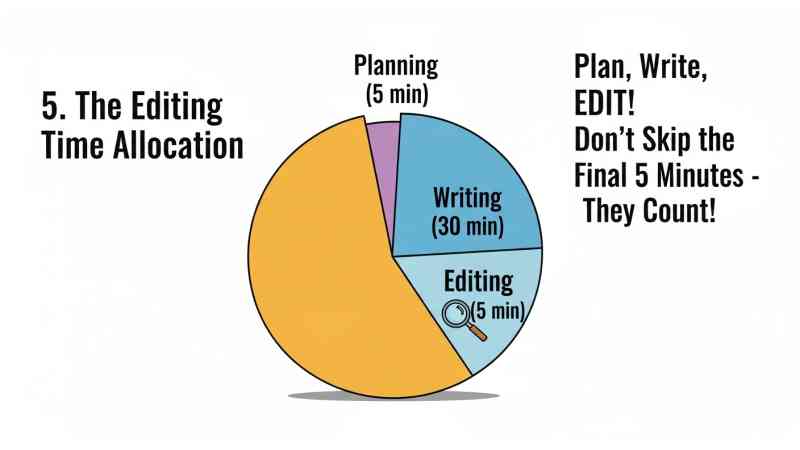
With just seconds to spare, do one more quick scan for anything missed. Check that you have met the word count (250+ words) – add a short sentence if you’re under. Verify that you’ve written in the correct format (e.g. no informal contractions like “isn’t” or “won’t” if you’re not sure about them; in Writing Task 2 essays it’s safer to use “is not”, “will not”). Fix any glaring punctuation mistakes (e.g. add a missing period or capital letter at the start of a sentence).
Make sure any numeric data (years, percentages, etc.) is accurate if you included them. Ensure your final paragraph is indeed a conclusion (it should not introduce new ideas, just summarize your stance). If you notice an off-topic sentence at the very end, remove it. In essence, use whatever time is left to polish surface details.
Remember: by systematically going through each of these points – grammar, clarity, vocabulary, task completion, and cohesion – you can significantly improve the quality of your essay. Test-takers who practice this final check process report higher scores, because it catches the kind of small errors that often hold people back. A few minutes of careful editing can be the difference between Band 6 and Band 7 (or higher) in Writing Task 2.
Conclusion
Your IELTS Task 2 score depends not just on good ideas, but on communicating them clearly and accurately. By following the simple editing checklist above – using your last 5 minutes to eliminate grammar errors, clarify your points, enrich your vocabulary, and tighten the flow – you give yourself every chance to impress the examiner. Remember that the final minutes are for polishing, not rewriting; focus on quick fixes that sharpen your message. As the experts say, using those minutes wisely is “vital”.
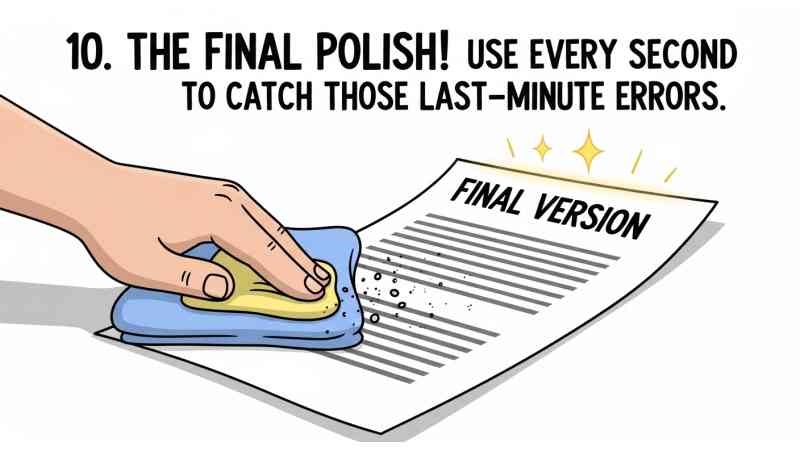
In short, treat your finished essay as a draft that can still be improved. Use a calm, friendly mindset in this last stage: you’re refining a piece you’ve already written, bit by bit. Over time, make editing part of your practice routine – look back at practice essays, find your common errors, and get into the habit of self-correction. This way, on test day you’ll confidently tackle the final minutes with a clear strategy. With these IELTS Task 2 editing tips, you’ll be more likely to hand in an essay that is both accurate and articulate – and earn the band score you’re aiming for.
Related Sources: Guidance from IELTS instructors and official resources confirm that revising for grammar, coherence, and vocabulary in the final minutes is a smart way to boost your writing score. Practice these editing steps, and you’ll gain confidence that every word on the page is polished and precise.

About the AuthorWelcome to TechIELTS. I’m Md. Jahangir Alam, an experienced engineer with over 15 years in electrical and automation systems. Alongside my engineering career, I’ve developed a strong interest in English language learning and IELTS preparation.
I hold a Duolingo English Test score of 135 (IELTS 7.5 equivalent) and am currently pursuing an M.Sc. in Cyber Security from Royal Holloway, University of London. I use my technical background to create clear, structured IELTS learning materials for students and professionals.
👉 Connect on LinkedIn
